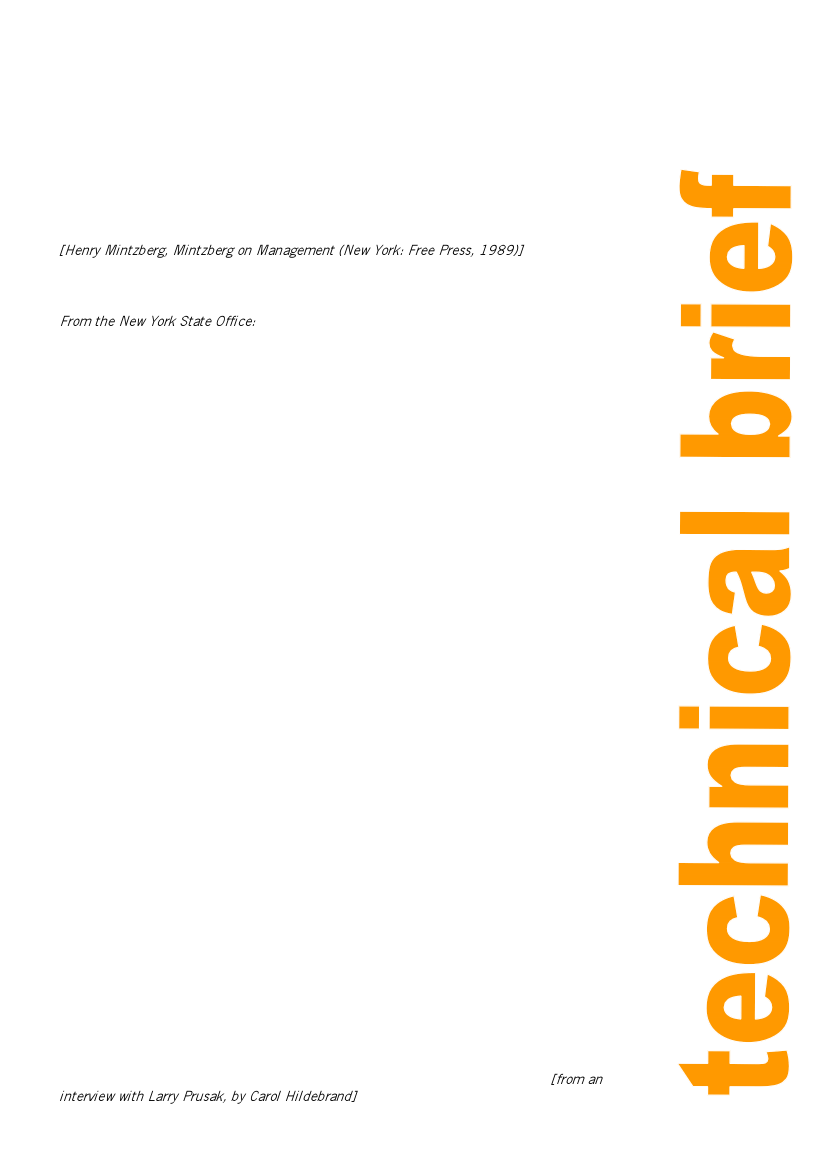
Knowledge Management Basics
Practical Action
a primary objective of the work. Both the inputs to and outputs from knowledge work have
high levels of variability and involve at least some degree of uncertainty, equivocality, and
incompleteness. The process of knowledge work tends to be variable, and difficult to analyze
as a set of procedures or steps. Characterized by exception rather than routine, it is
performed by professional or technical workers with a high level of skill and expertise.
Knowledge work processes include such activities as research and product development,
advertising, education, professional services like law, accounting, and consulting. We also
include management processes such as strategy and planning as part of knowledge work.”
[Henry Mintzberg, Mintzberg on Management (New York: Free Press, 1989)]
Why institutions should have a strategy for KM?
From the New York State Office:
“The word strategy comes from Greek roots meaning to lead an army. Today we use the term
more broadly to convey the idea of a "battle" plan designed to achieve a major objective.
Whether in business or in government, strategic thinking is concerned with mission-critical
objectives; it looks outward with an emphasis on customers and stakeholders. Strategies place
a high value on human, organizational, and technological resources and seek maximum return
on those investments, rather than minimized costs.
Successful strategic use of information in government entails five factors:
- understanding the business or program need
- negotiating the environment
- accounting for existing infrastructure, practices, history, and culture
- looking ahead to future conditions
- devising an unambiguous approach
The first element of strategy then is a clear and agreed upon picture of the business, policy,
or program need that is the reason for the effort. Easy as it is to say, this is very difficult to
achieve. One reason for the difficulty is that different people see different symptoms and not
the problem as a whole. The underlying problem is usually embedded in at least one business
process and what you see depends on where you are connected to that process. The necessary
analysis to uncover and define the problem cannot be a solitary effort, but one that must
include all relevant perspectives.
While many KM strategies have been made possible by technology, IT-centric approaches
have had limited success. Rather, informal employee networks and other workplace practices
have been more successful at turning knowledge into action. The active participation of both
IT and HR in knowledge management initiatives will be critical for success in the bigger
payoff--deeper customer relationships with a fully
engaged workforce.
A knowledge management strategy can be presented as a further enhancement to and
rationalisation of existing government legislation and policies; it can serve as a bridge
between the legislation governing specific sectors and the legislation governing the
management of information. “
CIO: What do you see as the next trends in KM?
Prusak: Well, there seems to be a growing consensus among companies doing knowledge
management that the correct focus should be neither on the individual or the enterprise, but
instead on some grouping of people who share common context, stories and passion, around a
subject. For example, Ford has a lively community that grew up around the subject of new
brake technology. World Bank has 126 different groups that discuss topics as diverse as
aquatic agriculture. I think such groups represent the right type of unit to share knowledge.
It's not about one individual, or the entire enterprise. These people want to help each other
out; you don't have to incense them. Instead, you see more and more alignment. [from an
interview with Larry Prusak, by Carol Hildebrand]
9